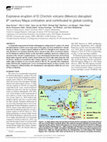Scientific papers by Tim Winkels

A remarkably long period of Northern Hemispheric cooling in the 6 th century CE, which disrupted ... more A remarkably long period of Northern Hemispheric cooling in the 6 th century CE, which disrupted human societies across large parts of the globe, has been attributed to volcanic forcing of climate. A major tropical eruption in 540 CE is thought to have played a key role, but there is no consensus about the source volcano to date. Here, we present evidence for El Chichón in southern Mexico as the most likely candidate, based on a refined reconstruction of the volcano's eruption history. A new chronological framework, derived from distal tephra deposits and the world's largest Holocene beach ridge plain along the Gulf of Mexico, enabled us to positively link a major explosive event to a prominent volcanic sulfur spike in bipolar ice core records, dated at 540 CE. We speculate that voluminous tephra fall from the eruption had a severe environmental impact on Maya societies, leading to temporary cultural decline, site abandonment, and migration within the core area of Maya civilization.
Papers by Tim Winkels

<p&amp... more <p>River embankments form an essential part of the primary flood defence in the Netherlands. Of all failure mechanisms, piping is considered one of the key mechanism for triggering dike destabilization of river dikes in Rhine-Meuse Delta. Within the STW project Piping in practice, we aim to better understand 1) the influence of variability within subsurface characteristics on the piping process, and 2) the natural variability of these subsurface characteristics underneath embankments in the Rhine-Meuse delta.   <br>We employ the lithogenesis of sandy deposits to group variability in subsurface parameters across different scales. Using extensive borehole datasets, we quantified regional trends within and between geological units in order to investigate geological controls on variability these subsurface properties. On a smaller scale, laboratory experiments have shown that larger variation in grain size or layering in porous media have a retarding effect on the progression of small-scale pipes, demonstrating the importance of incorporating these variabilities into the piping assessments.  Combining laboratory experiments and field observations, representative sedimentary architectures are implemented into digital piping models at several embedded scales. This will allow us to better describe subsurface variability in terms of model parameters, and improve computation of the piping process.</p>

The beach-ridge sequence of the Usumacinta-Grijalva delta borders a 300-km-long section of the So... more The beach-ridge sequence of the Usumacinta-Grijalva delta borders a 300-km-long section of the Southern Mexico Gulf coast. With around 500 beach ridges formed in the last 6500 years, the sequence is unsurpassed in the world in terms of numbers of individual ridges preserved, continuity of the record, and temporal resolution. We mapped and dated the most extensively accreted part of the sequence, linking six phases of accretion to river-mouth reconfigurations and constraining their ages with 14C and OSL dating. The geomorphological and sedimentological reconstruction relied on LiDAR data, coring transects, GPR measurements, grain-size analyses and chemical fingerprinting of volcanic glass and pumice encountered within the beach and dune deposits.
We demonstrate that the beach-ridge complex was formed under ample long-term fluvial sediment supply and shorter-term wave- and aeolian modulated sediment reworking. The abundance of fluvially supplied sand is explained by the presence of easily weatherable Los Chocoyos ignimbrites from the ca. 84 ka eruption of Atitlán volcano (Guatemala) in the catchment of the Usumacinta River. Autocyclic processes seem responsible for the formation of ridge/swale couplets. Fluctuations in their periodicity (ranging from 6–19 yrs) are governed by progradation rate, and are therefore not indicative of sea level fluctuations or variability in storm activity. The fine sandy beach ridges are mainly swash built. Ridge elevation, however, is strongly influenced by aeolian accretion during the time the ridge is located next to the beach. Beach-ridge elevation is negatively correlated with progradation rate, which we relate to the variability in sediment supply to the coastal zone, reflecting decadal-scale precipitation changes within the river catchment. In the Southern Mexican delta plain, the coastal beach ridges therefore appear to be excellent recorders of hinterland precipitation.









Uploads
Scientific papers by Tim Winkels
Papers by Tim Winkels
We demonstrate that the beach-ridge complex was formed under ample long-term fluvial sediment supply and shorter-term wave- and aeolian modulated sediment reworking. The abundance of fluvially supplied sand is explained by the presence of easily weatherable Los Chocoyos ignimbrites from the ca. 84 ka eruption of Atitlán volcano (Guatemala) in the catchment of the Usumacinta River. Autocyclic processes seem responsible for the formation of ridge/swale couplets. Fluctuations in their periodicity (ranging from 6–19 yrs) are governed by progradation rate, and are therefore not indicative of sea level fluctuations or variability in storm activity. The fine sandy beach ridges are mainly swash built. Ridge elevation, however, is strongly influenced by aeolian accretion during the time the ridge is located next to the beach. Beach-ridge elevation is negatively correlated with progradation rate, which we relate to the variability in sediment supply to the coastal zone, reflecting decadal-scale precipitation changes within the river catchment. In the Southern Mexican delta plain, the coastal beach ridges therefore appear to be excellent recorders of hinterland precipitation.
We demonstrate that the beach-ridge complex was formed under ample long-term fluvial sediment supply and shorter-term wave- and aeolian modulated sediment reworking. The abundance of fluvially supplied sand is explained by the presence of easily weatherable Los Chocoyos ignimbrites from the ca. 84 ka eruption of Atitlán volcano (Guatemala) in the catchment of the Usumacinta River. Autocyclic processes seem responsible for the formation of ridge/swale couplets. Fluctuations in their periodicity (ranging from 6–19 yrs) are governed by progradation rate, and are therefore not indicative of sea level fluctuations or variability in storm activity. The fine sandy beach ridges are mainly swash built. Ridge elevation, however, is strongly influenced by aeolian accretion during the time the ridge is located next to the beach. Beach-ridge elevation is negatively correlated with progradation rate, which we relate to the variability in sediment supply to the coastal zone, reflecting decadal-scale precipitation changes within the river catchment. In the Southern Mexican delta plain, the coastal beach ridges therefore appear to be excellent recorders of hinterland precipitation.